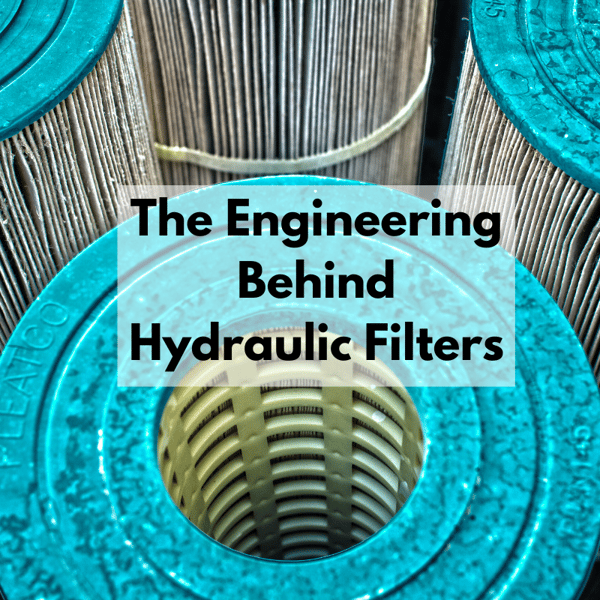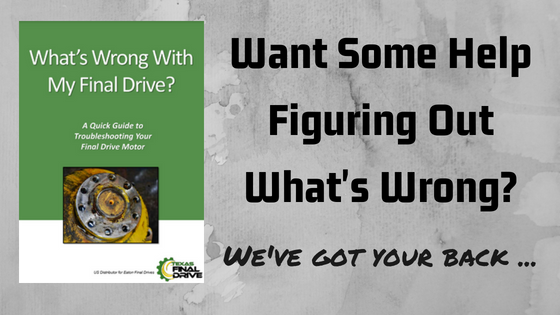Hydraulic filters are a critical component of any hydraulic system, including your compact equipment. And when they fail, it can be catastrophic for your final drive motor. In this blog post, you will learn about the engineering that goes behind the design and selection of these filters.

Here are a few other Shop Talk Blog posts you might find of interest:
- 4 Things to Remember About Hydraulic Filters
- 4 Horrifying Final Drive Failures
- The Basics of Mini Excavators
Typical Filters on Compact Equipment
All hydraulic systems have filters, and there are certain ones that commonly found on compact equipment.
The pump inlet line will usually have one of two types of filters/strainers: a suction filter or a sump strainer. Suction filters, if they are included in a hydraulic system, are immediately upstream of the system pump either submerged in the reservoir or on the suction port of the pump. These filters can be extremely problematic if they get clogged. A sump strainer, on the other hand, focuses on trapping coarser particles than the suction filter.
There are also filters on high-pressure working lines, which would be placed between the pump outlet and other system components. They are used to (1) catch contaminants that have passed through the pump from the reservoir or (2) have been generated by the pump or other components that are upstream of the filter.
Low-pressure return line filters are tasked with capturing contamination that has been generated by hydraulic components, of which final drive motors and hydraulic cylinders are good examples. Case drain filters fall under this category.
Filters vs. Strainers
Both filters and strainers remove contamination from hydraulic fluid. Hydraulic filters and strainers are not the same, however. According to the Fluid Power Journal, strainers can capture contaminants you can see, such as a grain of sand. Filters, on the other hand, can capture contaminants that are invisible to the naked eye, down to particles that are smaller than a red blood cell.
Now, if you’re wondering why we don’t just use filters, there’s a good reason: filters would quickly get clogged and overwhelmed by the kind of particles that strainers catch.
There are more differences between strainers and filters. Because strainers are more coarse than filters, they don’t resist the fluid flow as much as filters and lead to a much smaller pressure drop. This also means that you’ll often see strainers used on pump suction lines.
Filters are much finer and will have a more significant impact on pressure and fluid flow. The finer the filter, the more of a pressure drop will result from it, and the more quickly it will need to be replaced. This is a good reason why you should follow manufacturer recommendations for the type and micron rating of the filters you use.
Micron Ratings
The micron rating refers to the smallest size of particles that a filter can capture. Higher micron ratings are more coarse, while smaller micron ratings are finer. If you have a 40-micron filter, it can capture everything larger than 40 microns.
To get a better understanding of what a micron is, consider this:
- 70 microns is about the size of a grain of sand
- A typical human hair is between 40 and 80 microns in diameter
- 40 microns is the smallest particle that a healthy human eye can discern
Consider this:
Most hydraulic strainers are rated between 74- or 149-micron. Therefore, if you have an 80-micron strainer located in the system before a 40-micron filter, then theoretically, the filter would never need to capture particles that are 80 microns or greater in size. However, in reality, there is still that potential, and an excellent example would be internally generated contaminants. These contaminants are especially an issue after a major hydraulic failure. This is why it is essential to replace filters after a catastrophic failure. In fact, after a significant hydraulic failure, experts recommend that you change the filters, perform a system flush, then replace the filters again.
Types of Filter Materials
For hydraulic systems, most hydraulic filters are made from materials such as
- Micro-fiberglass
- Steel wire mesh
- Cellulose
- 80/20 Cellulose + Polyester
Now case drain filters can be a major exception, but we’ll talk about those in a minute.
Micro-fiberglass, sometimes referred to simply as microglass, are used for fine filtration. These filters usually have a pleated structure for added strength and filtration area. Microglass filters are manufactured by bonding the fiberglass with resin in multiple layers, making for a strong, extremely efficient filter. However, these filters are not reusable.
Steel wire mesh filters are used to capture larger particles and often used for strainers. In addition, they can be designed with considerable strength. When stainless steel is used, these filters can handle large pressure differentials. Wire mesh filters are also handy because they can be cleaned and reused.
Paper filters, also known as cellulose filters, are made from resin-impregnated cellulose that is pleated. They aren’t very effective and can lead to a significant pressure drop, but they are cheap. However, 80/20 cellulose polyester blend filters overcome the pressure drop problem and last longer than cellulose filters.
Pressure Drop
When specifying the filters for a hydraulic system, engineers have to trade between flow restrictions/pressure drop and the size of particles to be removed. We mentioned earlier that more refined filters result in more flow restriction and a pressure drop. And pressure drops can be a significant problem for hydraulic systems. For example, every time there is a valve, bend, hydraulic line, fitting, or connector, there will be a slight pressure reduction. This is caused by the friction resulting from flow through these components. That friction is lost energy which takes the form of a pressure drop -- and the same is valid for filters.
However, the filter isn’t the only thing affecting the pressure drop. Engineers also have to consider
- The viscosity of the hydraulic fluid, because higher viscosity fluids have a more challenging time getting through the filter, and that leads to a more significant pressure drop)
- The flow rate, because the faster the fluid is trying to flow, the more effort it takes to get through the filter
- What the filter is composed of because the more consistent the pore size, the easier it is for the fluid to pass through
Why It’s Important to Replace Your Hydraulic Filters
Two things can happen when a filter gets clogged: (1) the increase in pressure triggers the bypass valve, and the fluid is no longer filtered; or (2) the fluid cannot go anywhere, and the pressure in the line keeps increasing. Either case can be disastrous for your hydraulic system. If the bypass valve is activated, then the fluid in that line is no longer being filtered. Therefore, if contamination enters the system upstream from that filter, it will continue unchecked.
If you own a Bobcat machine, there’s a good chance it has an in-line case drain filter. This filter is on the low-pressure return line between the final drive motor and the reservoir. The case drain filter has a 40-micron rating and made of porous sintered bronze. And the case drain filter is an excellent example of why clean filters are critical to your hydraulic system and your final drive motor.
If the case drain filter gets clogged, there is no place for the fluid to go because this return line doesn’t have a bypass valve. As a result, the pressure in the final drive motor builds up. The longer it runs, the more that pressure builds up until it has to find somewhere for the fluid to go. If you don't catch the problem fast enough, you can end up with a totaled final drive.
And don't forget that buying cheap filters puts your hydraulic system in danger.
Conclusion
We encourage you to change out your filters according to manufacturer recommendations, and replace the case drain filter (if your machine has one) when you do the other filters. If a component in your system suffers a catastrophic failure, we also encourage you to flush the system and change out the filters.


